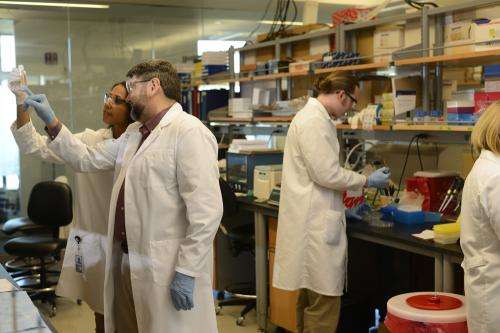Researchers identify target to prevent hardening of arteries

The hardening of arteries is a hallmark of atherosclerosis, an often deadly disease in which plaques, excessive connective tissue, and other changes build up inside vessel walls and squeeze off the flow of oxygen-rich blood throughout the body. Now, researchers at Sanford-Burnham Medical Research Institute have described the molecular and cellular pathway that leads to this hardening of the arteries—and zeroed in on a particularly destructive protein called Dkk1.
Their study was published online today by Arteriosclerosis, Thrombosis, and Vascular Biology. The findings suggest that the development of drug therapies to selectively inhibit endothelial Dkk1 signaling may help limit arteriosclerotic disease.
"I think the strategy going forward is to find ways to modulate or inhibit Dkk1 function, but we're going to have to do it in a time-sensitive and cell type- specific fashion," said Dwight A. Towler, M.D., Ph.D., director of Sanford-Burnham's Cardiovascular Pathobiology Program and senior author of the study. "In diseases such as chronic renal deficiency or diabetes, where unregulated Dkk1 signaling can be destructive, it may be appropriate to restrain the action of Dkk1 for a prolonged period of time," Towler added.
When the inflammatory response goes awry
The Dkk1 protein, when functioning normally, is important for aiding in wound repair. But inflammatory responses triggered inside artery walls after the onset of hyperglycemia, and other metabolic injuries associated with diseases like diabetes, can trigger prolonged and destructive Dkk1 signaling.
Dkk1 triggers the conversion of cells that line the interior surface of artery walls, called endothelial cells, into mesenchymal cells, which can direct connective tissue formation. This process is known as the endothelial-mesenchymal transition. The resulting fibrosis inside arterial walls leads to a dangerous stiffening of vessels that increases systolic blood pressure and ultimately impairs distal blood flow.
Drug therapy strategies to target Dkk1
Drug therapies should focus on the places where Dkk1 inhibition is called for—the arteries, in the case of atherosclerosis—because healthy Dkk1 signaling regulates normal processes such as cartilage and joint remodeling. To enable this targeted approach, Towler said he hopes to develop a therapeutic drug that would include a Dkk1 inhibitor and a peptide—a short chain of amino acids—engineered to target specific vascular tissues.
Longtime Sanford-Burnham researcher and past president Erkki Ruoslahti, M.D., Ph.D., developed these homing peptides, which have been used to deliver cancer drugs to where they're most needed. "If we can target a Dkk1 antagonist to endothelial cells using the Ruoslahti peptides—or a similar strategy—that would be very, very powerful," Towler said.
Dkk1 is from a family of molecules that arose during the development of vertebrates and is involved in heart formation in embryos. Researchers initially thought the protein's only role was to inhibit a molecular pathway known as canonical Wnt signaling, which controls cell differentiation. However, these new data identify surprising "cross-talk" between Dkk1 and a bone-inducing pathway previously shown to promote the endothelial-mesenchymal transition.
Towler and his team will continue to study Dkk1 and Wnt signaling to identify potential drug targets to prevent the hardening of arteries in patients with atherosclerosis.















